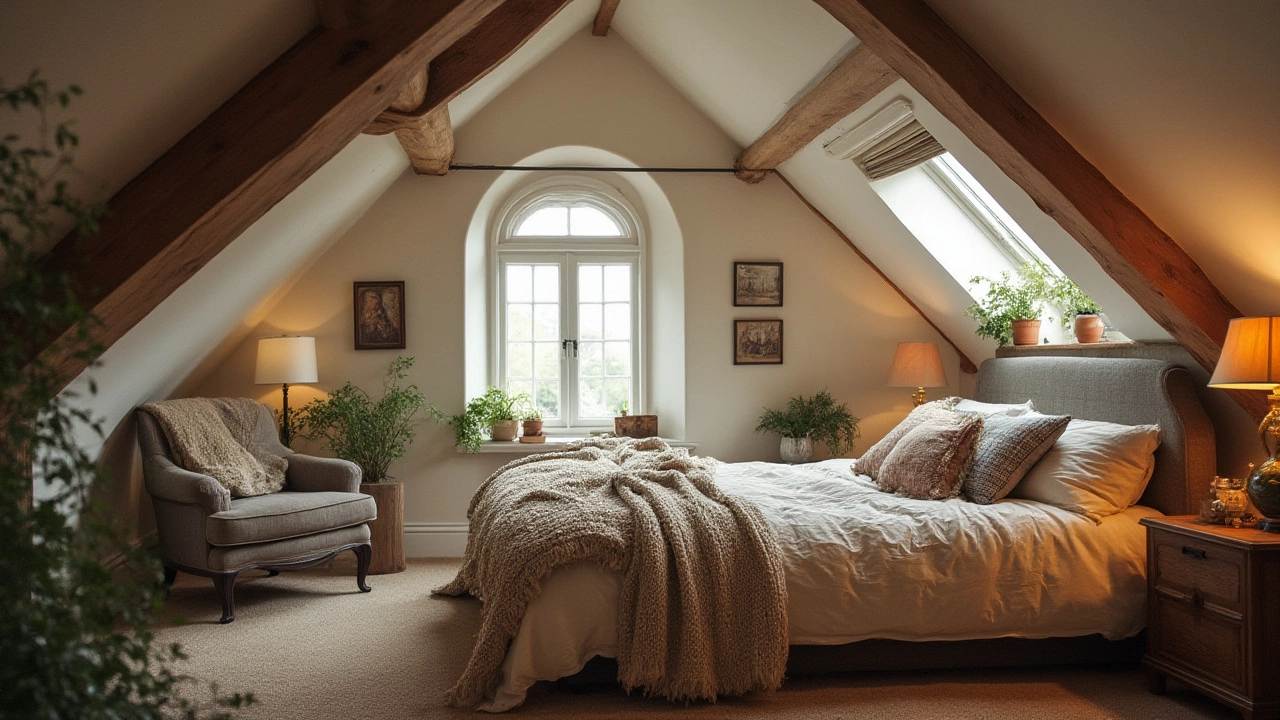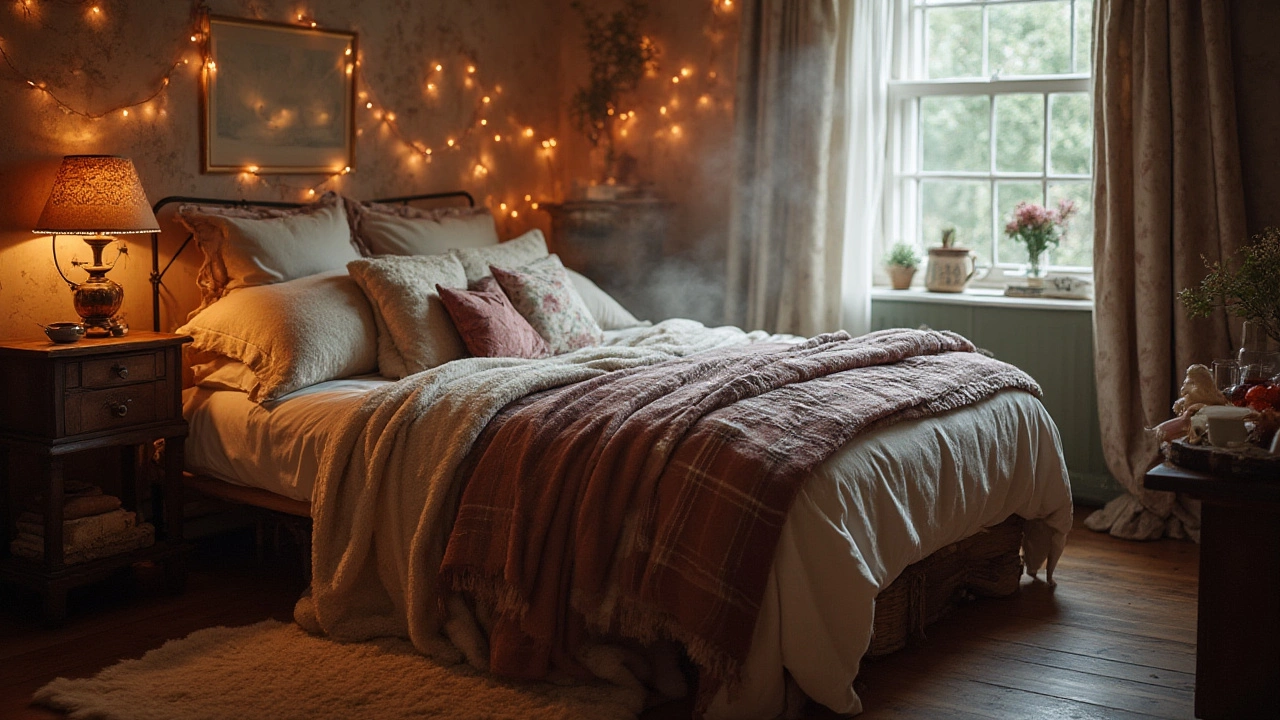If your bedroom feels like a bland box or the furniture catalog look never matched your style, you're not alone. Forty percent of Americans admit their bedroom isn't relaxing enough, even though it's where most of us want to unwind after the daily chaos. Walls that feel cold, a bed that's more functional than fun—yep, that's way too common. But here's a little secret: you don’t need a total renovation or deep pockets to flip your room into the cozy sanctuary dreams are made of. From surprising color tweaks to the magic of fabrics, even small changes will have you hitting snooze on your alarm just to spend more time in bed.
The Power of Textures: Layering for Warmth
Ever notice how your favorite hotel seems to wrap you up in comfort, no matter the season? The magic is in layers and texture. Think beyond your basic sheets—softness comes from mixing and matching. Start with classic cotton sheets (bonus points for a thread count around 400, which strikes the perfect balance between softness and breathability), and add a chunky knit blanket or a velvet throw for instant visual and tactile warmth. Drape a faux fur rug close to your bed—studies from the Woolmark Company found that soft floor textures actually trigger comfort signals in the brain.
Now, pile on the pillows. Don’t limit yourself to two sad pillows pushed against the headboard. Go for a mix—big euro shams at the back, a couple of standard pillows, and some smaller decorative ones in front. The trick is to vary your pillow materials: crisp linen, smooth sateen, even a fluffy chenille one for surprise. All these textures catch the eye and feel rich to the touch.
Let’s not forget curtains—they’re an underrated weapon in the war against sterile spaces. Heavy, lined drapes in natural fabrics like cotton or linen help absorb sound (bonus: they block unwanted light when it’s time for deep sleep). If blackout isn’t your vibe, layer sheer panels underneath to keep things airy, but always aim for floor-to-ceiling length. The longer the drapery, the cozier the vibe—it creates a cocoon effect that instantly softens the whole room.
On furniture, even inexpensive upgrades make a difference. Toss a textured runner at the foot of your bed or opt for a knit pouf or low ottoman for a spot to put on socks or toss your bag. Wood, wicker, and metal mixed together on furniture add coziness by mixing cool and warm visual notes—science says we’re wired to feel relaxed in tactile, nature-inspired environments. So, swap that plastic lamp base for something handmade, or put a woven tray on your dresser for your watch and wallet. Little things, big mood change.
Lighting: Creating Soft, Warm Glows
Lighting seriously changes the vibe. That one ceiling light? Ditch it as your main source if you’re after a cozy look. Start with soft, layered lighting instead. Table lamps with fabric shades are winners—they diffuse the light for a golden, inviting glow. String lights aren’t just for college dorms, either. Try looping a strand around your headboard or window frame, or tuck fairy lights into a glass vase on your nightstand for a dreamy look that doesn’t scream ‘teenager.’
Place several light sources at different heights. A reading lamp by the bed, a floor lamp in the corner, maybe even a small sconce above your cozy reading chair if you have space. This spreads the light out, reducing harsh shadows and making the room feel wrapped in warmth. Bulbs matter, too: look for ‘warm white’ LED bulbs (2700K on the color temperature scale) instead of ‘daylight’ bulbs. The lower Kelvin number means more yellow, less blue, which tricks our brains into feeling safe and comfortable—exactly what you want in a bedroom. Fun fact: a 2023 Philips study found that soft, warm lighting in bedrooms can improve relaxation and make falling asleep easier for more than 73% of adults.
Dimmer switches are your friend. Swapping in a dimmer isn’t expensive—most hardware stores have plug-in or battery-powered versions that work without rewiring. Being able to nudge the brightness down instantly gives your room chill vibes, perfect for winding down with a book or setting the mood for a lazy Saturday morning. And if you want to get fancy, smart bulbs that can change warmth, hue, and brightness through your phone or via Alexa are getting more affordable by the day. You can even set them to mimic the sunrise for a gentle wake-up. That’s a level of luxury no five-star hotel can beat.
Don’t forget candles (but play it safe—use flameless LED candles if you’re forgetful). A cluster of three at different heights on your dresser or nightstand brings not just a golden glow but a subtle, flickering movement that feels more intimate than electric lights ever could. If you want a signature scent, try lavender or vanilla. Science says those two are most likely to trigger relaxation responses in your brain. It’s not just about seeing the light—it’s about how it makes the whole room feel.

Color, Pattern, and Personal Touches
The right colors can morph a room from “eh” to “ahh.” Forget the myth that to make a room cozy, you always need dark walls. Yes, deep green or navy can make things snug, but soft grays, warm taupes, or buttery creams do the job without making the place feel small. If you like color, try accenting with blush, terra cotta, or mustard. These shades echo natural earth tones, soothing your senses and making the space feel like a hug, not a cave.
Patterns add interest without chaos. If ‘cozy’ is your goal, go for gentle, organic patterns—think florals, subtle stripes, or even traditional plaid. Layer these with solids to steer clear of a cluttered look. You’ll be surprised, but even a well-placed patterned lampshade or a set of mismatched bedside tables gives things a homey, lived-in edge. A survey by Apartment Therapy found rooms with mixed patterns and colors were rated 28% cozier by guests compared to monotone or highly coordinated rooms.
Your personality deserves pride of place. That favorite black-and-white snapshot from high school? Frame it. Kids’ artwork, postcards from your travels, ticket stubs, or even vintage finds from a thrift shop—they all tell your story. Hang art in clusters (a ‘gallery wall’) above the headboard or on the wall opposite the bed. For a cozier result, stick with frames in the same color tone (all black, or wood, or white) but mix sizes and shapes. Or, go for picture ledges so you can shuffle things around whenever the mood strikes.
It’s not just what you put in the room but how you arrange it. Camouflage the TV if you must have one—try hanging art above it, or tuck it in an armoire when not in use, so your bed stays the main event. And something as simple as a stack of books on the nightstand or a favorite mug becomes a signal that this is your space to relax, not just pass through. A cozy bedroom isn’t about copying Pinterest boards—it’s about mixing what makes you happy with features that encourage comfort.
Smart Layout: Fixing Flow and Creating Retreat Zones
The coziest bedrooms, big or small, make you want to kick off your shoes and stay awhile. You don’t need a huge space to make it work—just pay attention to how things are arranged. Start by getting the bed in the right spot. If possible, avoid pressing it against too many walls. Designers often suggest centering the bed along the largest wall with enough space to walk on both sides, which not only looks balanced but stops it feeling like you’re tucked in a dorm room corner. If your space is tight? Slide it to one side, but make up for the imbalance with a small shelf or lamp to keep things from feeling lopsided.
Consider the view from your pillow. The first thing you see in the morning should be something that makes you smile, not laundry piles or clutter. If your bed faces a blank wall, hang photos or art that lift your mood. Or, leave the windows unobstructed and wake up to the morning light—just pair it with blackout curtains so you’re in control.
Zones matter, especially in city apartments or shared houses. Nudge a chair and tiny table into a corner for a ‘reading nook’ (big bonus for a throw blanket and small plant). Even a bench at the foot of your bed or a compact desk works if you mix the right textures and colors to keep it inviting. And speaking of plants—the latest NASA Clean Air Study shows that even a few small plants (like peace lilies or snake plants) can freshen bedroom air and boost relaxation, not just provide Instagram cred.
Storage can quickly ruin or rescue your cozy dream. Bulky dressers and overflowing hampers equal chaos. Opt for storage pieces with legs—they lift up the visual weight and help small spaces feel airier. Baskets with lids look neater than open ones and are easy to stash under beds or on closet shelves. Keep surfaces as clear as possible, but don’t go overboard on minimalism—some bedside clutter, like a good book or a charging phone, makes rooms feel lived-in, not showy.
Laying out your room with comfort in mind also means thinking about routine. Lay out your clothes for the week in advance on a wall hook or valet stand, so mornings are a little less frantic. Put a soft rug beside the bed so your toes don’t hit cold floor first thing. If you share a space with a partner, divide drawers or closet space and keep each side of the bed functional for two people. Small fixes, big difference—data from the National Sleep Foundation says an organized, visually calm bedroom can improve your sleep quality by up to 50%.
If you’re after data to help you get started, here’s a quick cheat sheet on what cozy bedrooms have in common, according to a 2024 U.S. Home Habits survey:
| Feature | % of Cozy Bedrooms |
|---|---|
| Layered Bedding and Pillows | 87% |
| Soft Lighting/Dimmers | 81% |
| Mix of Textures | 75% |
| Personal Touches (Photos, Art) | 72% |
| Natural Elements (Plants, Wood) | 69% |
Bottom line? A cozy bedroom is all about tweaking your own space—playing with layers, playing with light, and, most importantly, showing off what matters to you. No major overhauls needed. Just a few smart changes, and you’ll look forward to going to bed every single night.
